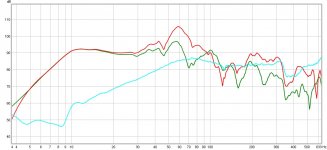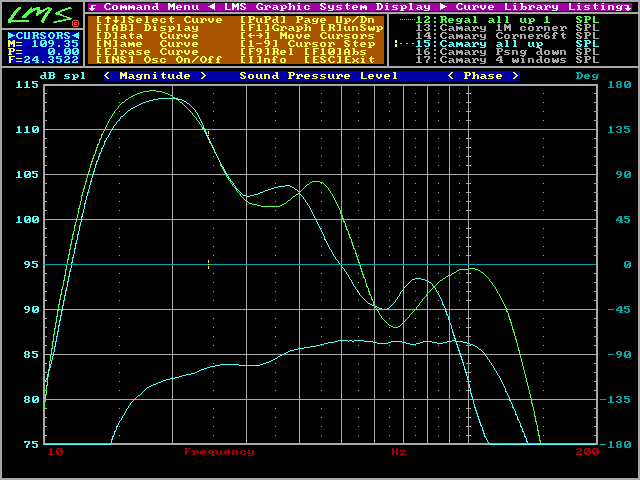ok but why I can't get more than 127dB at 60hz with two tham12? maybe a bit more...
Try at an excursion minimum, and just ramp up the power. 4kW per driver, and set it in 0.5pi space.
Those are the sort of conditions the SPL people are using. Most good drivers will stand that power for half a second or so without melting.
Chris
ok but why I can't get more than 127dB at 60hz with two tham12? maybe a bit more...
Those tham 12's are measured in 2pi enviroment I'll guess... Cabin gain and resonances boost the "output" a lot.
Here are some measurements I did; a 12" in a closed box, levels are at 2V.

- Blue is outside, 1 meter, 2pi, same as the models predict.
- Green is measured at the drivers head, sub in the trunk.
- Red is measured near the windshield. This is where spl is generally measured in dB drags.
The flat to 10Hz is caused by cabin gain.
The boost at 58 Hz is caused by a resonance related to the length of the car.
As you see, output is about 20dB higher at 58Hz.
If I were to make a ported box that would do peak to 100dB at 1watt at 58hz, it would do 120dB in this car. Add 1kW of power and you're at 150dB.
Offcourse, in real life there would be some losses, and obviously it would sound like crap. But i hope you understand now how they get such high levels in cars 😉
Hi carneoleon,The boost at 58 Hz is caused by a resonance related to the length of the car.
Could you explain what you mean with "the length" in relation to the "resonance", you referring to?
Cheers,
Djim
The interior of a car can be simplified to a tube with both ends closed. In such tubes the lowest resonance occurs approximately at the frequency at which 1/2 wavelength = tube length.
Hi TBTL,The interior of a car can be simplified to a tube with both ends closed. In such tubes the lowest resonance occurs approximately at the frequency at which 1/2 wavelength = tube length.
As far as I know tubes with both ends open function as ½ wavelength resonators.
Cheers,
Djim
The interior of a car can be simplified to a tube with both ends closed. In such tubes the lowest resonance occurs approximately at the frequency at which 1/2 wavelength = tube length.
Exactly.
I've been to quite a few sound-offs, and here's some strange things I've noticed:
1) The smallest cars often perform the best
2) I see a lot of guys pull up in SUVs full of eighteens, only to get beat by people in hatchbacks with a single woofer.
I think that what's going on here is that the car is behaving like a resonant pipe. So to maximize SPL, the goal isn't to have the loudest woofer, the goal is to have a rigid vehicle with a lot of flexibility in woofer placement. I think that's why the SUVs with a pile of eighteens don't win. When you have an eight cubic foot enclosure, you don't have any real flexibility in placing the enclosure. When you have an 8" woofer in a 1 cubic foot box, you can place the enclosure in EXACTLY the right spot to maximize SPL. It's similar to how we make horns in Hornresp, changing the length of the line to get the right response.
TLDR: to get max SPL you want a really rigid vehicle with a lot of power into a woofer that's small enough to be put in the spot where SPL is maximized. The whole car is the enclosure.
Hi Patrick Bateman,I think that what's going on here is that the car is behaving like a resonant pipe.
If car interiors were behaving like 'resonant tubes' (1/2 or 1/4 wavelength resonators) they should have at least one end open! It should also leave the evidence in the impedance plots.
However, I do agree partly with carneoleon in post#22 about the cabin gain. They are very small rooms that do act like pressure chambers. Instead of the distinguish resonances of a ½ wavelength resonator you see an almost chaotic and overlapping resonances. Doors, dashboard, metal sheets all resonate at their own frequency and act like vibro-acoustic resonators. Therefore the idea that car acoustics can be explained with simple 'room-modes' by length, height and width or act like a tube resonator is way too simplistic, in my view.
Cheers,
Djim
Last edited:
Hi Patrick Bateman,
If car interiors were behaving like 'resonant tubes' (1/2 wavelength resonators) they should have both ends open! It could also be seen in the impedance plots.
However, I do agree partly with carneoleon in post#22 about the cabin gain. They are very small rooms that do act like pressure chambers. Instead of the distinguish resonances of a ½ wavelength resonator you see an almost chaotic and overlapping resonances. Doors, dashboard, metal sheets all resonate at their own frequency and act like vibro-acoustic resonators. Therefore the idea that car acoustics can be explained with simple 'room-modes' by length, height and width or act like a ½ wavelength resonator is way too simplistic, in my view.
Cheers,
Djim

Actually you can see the resonances quite clearly. There's resonances due to the length of the cabin and due to the width. The width is approximate 72" (47hz) and the length is approximately twice that. (23.5hz)
All of this is complicated by the fact that resonances cut both ways, and the null produced by the width of the cabin is fighting the peak caused by the length, because they're right about the same frequency.
If you wanted to find the ideal car, you'd want one that was smaller than average, and one where the length was particularly short. Not coincidentally, some of the loudest cars out there are old Hondas, which are particularly short and small.
Hi Patric,Actually you can see the resonances quite clearly. There's resonances due to the length of the cabin and due to the width. The width is approximate 72" (47hz) and the length is approximately twice that. (23.5hz)
All of this is complicated by the fact that resonances cut both ways, and the null produced by the width of the cabin is fighting the peak caused by the length, because they're right about the same frequency.
Thanks for the plot. Like I said, they behave like small rooms (that have room modes too) that also act like pressure chambers. Since the length is not an consistent value because the back and the font are sloped & complex shaped, the acoustics cannot be simplified with just length, width and height, as if walls are perfectly parallel. In addition, the walls are also not rigid but act like vibro acoustic panels that release acoustic energy, which makes it even more complex.
Cheers,
Djim
Last edited:
oh, my anwser is not there :O I though I post it  ok let'S start again
ok let'S start again
my 2 tham12 are not side by side, there's my bed between them. one is on a wall the other about 6 inch of the wall! I don't have a lot of bass if i'm on my bed, but of i'm in front on the subs, there's a lot of bass, so I took mesurements on my bed, I remember that I test 1 of them in 1pi and I had 102dB at 45hz, wich is perfect for my use) the other tham (6inch of a wall) gave me about 97-98dB... the drivers are 1000W peak, I only feed them with 450W because I have to power all the system with only one amp(cos I only have one amp 😛) maybe coupled I would have a 3dB boost? and in a 0,5Pi another resonance boost! how to simulate a car cabin? maybe in my closet?
 ok let'S start again
ok let'S start againmy 2 tham12 are not side by side, there's my bed between them. one is on a wall the other about 6 inch of the wall! I don't have a lot of bass if i'm on my bed, but of i'm in front on the subs, there's a lot of bass, so I took mesurements on my bed, I remember that I test 1 of them in 1pi and I had 102dB at 45hz, wich is perfect for my use) the other tham (6inch of a wall) gave me about 97-98dB... the drivers are 1000W peak, I only feed them with 450W because I have to power all the system with only one amp(cos I only have one amp 😛) maybe coupled I would have a 3dB boost? and in a 0,5Pi another resonance boost! how to simulate a car cabin? maybe in my closet?
- Status
- Not open for further replies.
- Home
- Loudspeakers
- Subwoofers
- Incredible SPL with car 8"?